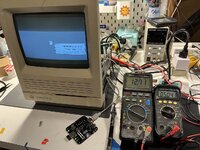So, the other day, while I was using it, my SE/30 experienced rather a dramatic failure, dying with a sharp "snap" and a smell of burning electronics.
I'd recapped it about a year ago with tantalum capacitors, but I hadn't touched the (Sony) power supply or analog board, so my first instict was to tear those down and look for failed components.
Bzzzt. Wrong.
After staring at the power supply and analog board for a while with no obvious clues, I thought I'd shelve it for now and started putting it back together... at which point I finally looked at the logic board, and saw that the top of C9 had been blown clean off! Yikes!
It's a weird failure - I know that using 16V tantalums on the + and - 12V lines is a little bit dodgy, but my understanding was that was more out of concern for long-term life of the capacitor than a risk of near-immediate failure! In the year since I recapped it, it's probably seen a few tens of hours of use - more than many vintage computers, I'm sure, but little enough that I think it's safe to call it a premature failure.
Out of an abundance of caution, I have also removed C10 (C9 is the main filter capacitor for the -12V line, C10 is its +12V counterpart); the machine runs fine without them, but I'll be replacing them with higher-voltage-rated parts to avoid a repeat of this.
Anyway, let this be a warning that it CAN happen to you! Choose your replacement capacitors with care!

Another interesting thing to note - I probed voltages at the power supply connector, and while the +5V rail was more or less spot-on, +12V was noticeably high at 12.7 volts! I'm assuming that this is at least in part because I'm using a BlueSCSI and don't have a spinning hard drive loading down the +12V rail, but I can't imagine that's good for things - would it be worthwhile to tweak the power supply's regulation adjustment down a bit and maybe end up with the +5V rail a bit below spec, or just leave it as-is?

I'd recapped it about a year ago with tantalum capacitors, but I hadn't touched the (Sony) power supply or analog board, so my first instict was to tear those down and look for failed components.
Bzzzt. Wrong.
After staring at the power supply and analog board for a while with no obvious clues, I thought I'd shelve it for now and started putting it back together... at which point I finally looked at the logic board, and saw that the top of C9 had been blown clean off! Yikes!
It's a weird failure - I know that using 16V tantalums on the + and - 12V lines is a little bit dodgy, but my understanding was that was more out of concern for long-term life of the capacitor than a risk of near-immediate failure! In the year since I recapped it, it's probably seen a few tens of hours of use - more than many vintage computers, I'm sure, but little enough that I think it's safe to call it a premature failure.
Out of an abundance of caution, I have also removed C10 (C9 is the main filter capacitor for the -12V line, C10 is its +12V counterpart); the machine runs fine without them, but I'll be replacing them with higher-voltage-rated parts to avoid a repeat of this.
Anyway, let this be a warning that it CAN happen to you! Choose your replacement capacitors with care!

Another interesting thing to note - I probed voltages at the power supply connector, and while the +5V rail was more or less spot-on, +12V was noticeably high at 12.7 volts! I'm assuming that this is at least in part because I'm using a BlueSCSI and don't have a spinning hard drive loading down the +12V rail, but I can't imagine that's good for things - would it be worthwhile to tweak the power supply's regulation adjustment down a bit and maybe end up with the +5V rail a bit below spec, or just leave it as-is?

